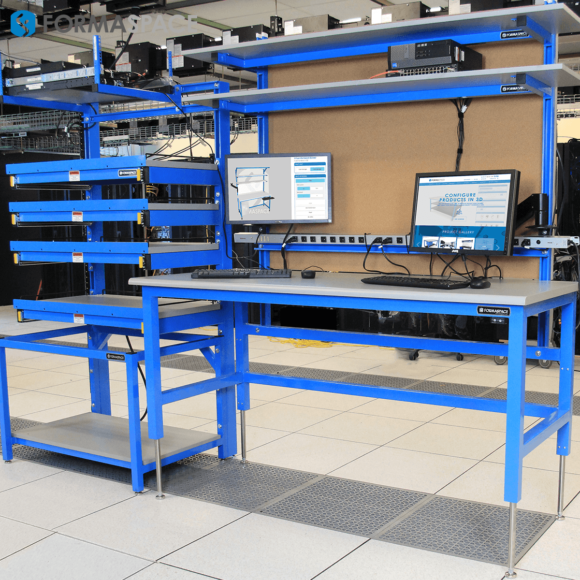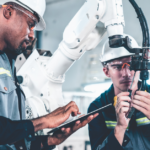Today we look at the top trends driving the aerospace industry in 2021.
This is our latest article in a series of market intelligence investigations. Be sure to check out our previous articles on which industries will grow the fastest in 2021, as well as the top trends in supply chain and logistics, pharma and clinical healthcare, furniture manufacturing, and high-tech.
1. A New Renaissance in Space Exploration Bridges the Political Divide
Space exploration is enjoying a new renaissance, with the US enjoying renewed pride in its recent accomplishments, such as the recent successful flight of NASA’s Perseverance Mars Lander and the launch of five astronauts this past November aboard a SpaceX Crew Dragon spacecraft (powered by a SpaceX Falcon9 rocket) en route to the International Space Station.
These achievements mark a new era in the space program, as NASA breathes a sigh of relief that it is no longer wholly dependent on Russian rockets to send astronauts into space.
But this week, all eyes are focused on NASA’s Perseverance Mars Lander and its Ingenuity Mars Helicopter, which will attempt the first-ever powered, controlled flight on another planet. The first takeoff test is expected very soon and will be broadcast on NASA television and on their YouTube channel.

We can expect more significant developments from NASA in 2021, including:
Additional CST-100 Starliner Flight Tests
- NASA’s Commercial Crew Program has two companies competing against each other: SpaceX and the Boeing/United Launch Alliance partnership. While SpaceX has already had one successful flight ferrying astronauts to the International Space Station, Boeing/United Launch Alliance’s CST-100 Starliner failed a critical flight test this past November. A retest in March has been delayed but expected later in 2021.
Double Asteroid Redirection Test (DART)
- Can we protect ourselves from asteroids barreling toward Earth? NASA’s Double Asteroid Redirection Test (DART) intends to find out by intentionally crashing into an asteroid to change its orbital path. Expect the mission to launch later this summer, with the asteroid crash test taking place late in 2022.
James Webb Telescope
- The Hubble space telescope, famous for needing to be fitted with corrective “glasses” after a math miscalculation in its optical lens system, will be joined by the new James Webb Space Telescope. The new telescope is expected to be launched in the fall of 2021 and will stake out a position orbiting the sun for a clear view of the cosmos.
Orion and Space Launch System tests for the Artemis 1 Moon Mission
- As part of NASA’s plan to return astronauts to the moon, dubbed Artemis 1, it will launch an unmanned test flight of the new Orion spacecraft and Space Launch System (SLS) rocket this fall. A successful test could pave the way for the launch of the Artemis one crew in 2023.
Space exploration remains popular among the American public. According to a new poll from Morning Consult, nearly 50% of Americans believe it’s essential that the United States continue to be a world leader in space exploration. When asked about specific programs, most respondents believe the top priorities for the space program should include:
- Monitoring the Earth’s climate system
- Monitoring asteroids that could strike Earth
- Developing tech not just for space exploration
Congress seems to have gotten the message.
Space exploration is actually one of the few political funding areas that competing political parties in Washington can agree upon, with both Democrats and Republicans supporting continued funding for NASA’s space exploration initiatives.
Nonetheless, NASA will need more money than the $24.7 billion that the Biden administration has proposed in its fiscal 2022 budget to fully fund a manned mission to Mars.

2. Life in Outer Space is Closer than You Think
Thanks to recent advances in space technology, the idea of living in space or traveling to Mars no longer seems like a far-fetched idea taken from science fiction books.
Much of the credit for this goes to Elon Musk, who has worked tirelessly in his quest for humans to land on Mars.
Last December, Musk’s company SpaceX performed the first major test of its SN8 prototype for its Next-generation “Starship” spacecraft / rocket system, which is the scaled-up successor to the successful Falcon9 program designed to take humans to Mars and back.
This private enterprise approach (albeit funded with lucrative government space launch contracts) is quite different from the government-run “space race” of the 1950s and 1960s and marks a major new trend.
And Musk is not the only civilian promoting space travel. He’s part of an elite “billionaires boys club” that are leveraging their fortunes to explore space, including Amazon’s Jeff Bezos (with his Blue Origin rocket company), the late Microsoft co-founder Paul Allen, and Virgin Galactic founder Richard Branson (with his stunning new SpaceShip III vehicles).
What if space travel becomes a common occurrence in the coming decade?
Even if space travel is widely available, the challenges ahead for our physical bodies are still daunting.
Recent studies of long-term visitors to the International Space Station quantify just how unprepared the human body is for life in space – with loss of bone mass, heart muscle shrinkage, and sustained radiation damage just a few of the most worrisome challenges.
And those looking to escape environmental problems here on Earth may well be disappointed that humans have already created what can best be described as a massive “garbage belt “ of space debris surrounding the Earth, which imperils the life of every astronaut passing through it. (This month, the Japanese company, Astroscale, launched its ELSA-d (short for End-of-Life Services) mission which will test new technology for “hoovering up” that prodigious amounts of junk in near-Earth orbit.
As we actively work toward colonizing the moon and Mars, we will also have to address another important scientific and philosophical question:
Are we the first life forms to get there?
Or are we following in the footsteps of life forms that preceded us?
This question about the existence of life in outer space has taken on new significance recently.
As NASA scientists prepare to look for signs of life on Mars, they have also been surprised to discover unexpected life forms (such as mold formations) within the confines of the International Space Station.
Meanwhile, discussions about alien life that were once relegated to the covers of sensational tabloids found at grocery store checkout counters are now appearing in more serious academic journals. For example, noted Harvard University astronomy Professor Avi Loeb recently wrote a book, Extraterrestrial: The First Sign of Intelligent Life Beyond Earth, about the peculiar cigar-shaped Oumuamua asteroid that passed between the Earth and the sun in 2017. Loeb believes it could have been a spacecraft pushed by the momentum of light particles built by a technologically advanced alien civilization.
Conspiracy theorists can rejoice, as this also comes at a time when the US Navy and other federal agencies tasked with collecting reports about UFOs have begun to release additional information, which may result in providing the public more questions than answers.
What should we do about this? According to Michio Kaku, a leading physics researcher in the field of string theory, the answer is simple: keep quiet. Here is Kaku’s statement as reported in the Guardian:
Soon we’ll have the Webb telescope up in orbit and we’ll have thousands of planets to look at, and that’s why I think the chances are quite high that we may make contact with an alien civilisation. There are some colleagues of mine that believe we should reach out to them. I think that’s a terrible idea. We all know what happened to Montezuma when he met Cortés in Mexico so many hundreds of years ago. Now, personally, I think that aliens out there would be friendly but we can’t gamble on it. So I think we will make contact but we should do it very carefully.

3. Airlines Fight for Financial Survival during the Coronavirus Pandemic
The trillion-dollar question facing the airline industry is how to make money again in 2021 – and keep one step ahead of bankruptcy.
During the height of the coronavirus pandemic, airline traffic fell by more than 90%.
Much like restaurants that suddenly switched to take-out service during the Covid lockdown, passenger airlines quickly took on as much cargo business as possible to keep flying during the height of the pandemic.
Fortunately, the US government stepped in several times to provide significant financial assistance to help the domestic air carriers stay afloat and retain their employees. European countries and other nations around the world have done the same.
Thanks to the success of the coronavirus vaccination programs here in the US, the domestic airline industry can now shift toward planning for the future.
One of the first priorities is gaining the trust of the traveling public and convincing them that it is safe to fly once again.
While there is a lot of pent-up demand for leisure travel, it’s not clear if the all-important, highly profitable business class flyers will return to the skies in numbers anywhere close to pre-pandemic levels.
With this in mind, airlines will have to restructure their operations, perhaps taking on more cargo business than before or reducing their flight routes and service frequencies to align with lower revenue models. Airline companies may also lean on other business models, such as beefing up their airline travel points businesses.
How quickly will airlines recover?
A lot depends upon how quickly the public gets vaccinated. The CDC says it safe for vaccinated people to fly, although they should continue to wear masks in flight.
What about vaccine passports? Many in the airline industry had pinned their hopes on requiring all passengers to show proof of vaccination as a way to quickly restore confidence.
However, this issue has been caught up in politics, with conservative Republican politicians such as Florida Gov. DeSantis recently signing new legislation that prohibits businesses from restricting service to those who choose not to be vaccinated.
This poses a dilemma for the airline industry as well as the cruise industry, both of which served the traditionally strong Florida leisure travel market.
Federal rules covering air transportation would trump Florida’s state law; however, the Biden administration has signaled it sees no upside wading into a food fight on vaccine passports.
This may put airlines in a difficult situation that could slow the industry’s path to recovery.
4. Fleet Management Trends: Say Goodbye to Quad Jets and Hello to Narrowbody Twins
The coronavirus pandemic dramatically accelerated the retirement of the industry’s largest quad jets from passenger service, including the venerable Boeing 747 (known as the Queen of the Skies) and the even larger double-decker Airbus A380.
To date, Boeing has managed to avoid closing the 747-8 production line entirely – though deliveries have slowed to a crawl. (The order book includes one high-profile order by the US Air Force for a new Air Force One presidential jet.)
Could the order book come back to life? Demand for freighters is high, and the backlog for freighter conversions of plentifully used passenger jets is years long. But so far, the only customer to order any of the latest 747-8 aircraft has been Lufthansa.
And that was before Covid. Today, Lufthansa, like other airlines, is disposing of its larger jets, including its fleet of older 747s and relatively newer A380s.
Airbus reportedly also put a few feelers out to see if there was interest in reviving its recently closed production line for the double-decker A380 by offering a new version that would dedicate one level to carrying passengers and the other freight. So far, this has not been enough to revive the program.
Where does that leave Boeing? The company hopes to revive its commercial jet business with its new 777X, a major refresh of its hugely successful wide-body 777, which features efficient new engines and a new wing design (with a wingspan so large it requires the wingtips to fold up during taxing operations on the ground).
But despite the new Boeing plane, many analysts believe we have transitioned to a new era of smaller airplanes.
The breakout star in this era is the Airbus A321XLR, part of Airbus’ new generation NEO update. The XLR, in this case, stands for “extra long range” and indeed, the aircraft can perform many of the flight profiles once handled by the aging Boeing 757 and 767 aircraft.
Boeing’s 737 MAX was launched to compete with the new NEO class of Airbus planes, but the effort failed to go to plan. After a financially ruinous couple of years, in which the 737 Max was unable to fly due to two fatal crashes related to its MCAS flight system, the plane has been recertified for passenger service in the US and Europe – albeit a recent wiring issue (unrelated to MCAS) system has caused some airlines to ground the jet at least temporarily.
Will Boeing regain its leadership position over Airbus? These fierce rivals are eyeing each other’s plans carefully, trying to guess who will make the next step toward building a next-generation middle of the market (MOM) airplane that would leapfrog the technology of both the Airbus A321 and the Boeing 737 MAX.
Adding to the speculation during a December earnings call, Boeing’s new CEO David Calhoun teased that Boeing is currently planning a new program to compete with the Airbus A321.
If that’s the case, we’ll certainly miss the comfortable wide-body travel experience on many transcontinental flights or the shorter hops across the Atlantic from city pairs such as Boston and London.

5. New Deadlines Set for Meeting Aviation Sustainability Goals
Covid is not the only existential threat to the airline industry.
There are increasingly vocal demands that aviation becomes an environmentally sustainable business, one that’s carbon neutral.
Countries outside the US are tackling the issue of aviation emissions head-on. For example, France is contemplating the elimination of flight routes that are well served by high-speed rail links.
Here at home, FedEx recently announced it will spend $2 billion to transform itself into a net-zero company by 2040.
And the trade association representing US airlines, Airlines for America, said its members have reached a commitment to achieve net-zero emissions by 2050.
While these dates may yet seem far in the future, they are well within the timeframe that airline executives and fleet managers consider when making hard choices about the future of their respective airlines.
Will the US administration also make a commitment to reduce aviation emissions?
If any announcement is forthcoming, it’s likely to take place after negotiations with Congress on its infrastructure bill (which are hoped to be concluded by August).
After that, we might expect some new US policy announcements in time for the 26th United Nations Climate Change Conference (COP26) in Glasgow, planned for the first two weeks of November 2021.
6. What will power tomorrow’s aircraft: Electric, Hydrogen, Synthetic, or Biofuels?
How can we achieve these net-zero goals?
To date, the airline industry has pursued many different paths to increase its overall energy efficiency, including less thirsty jet engines, advanced wing airfoils with integrated winglets that reduce drag, and lighter fuselage materials for greater fuel economy – and when all else fails, carbon offsets.
Unfortunately, while these improvements are real, they are small – just nibbles at the edge of the problem.
The bottom line is moving to net-zero aviation will require significant changes to aircraft propulsion systems and fuel systems.
The aviation consultant Leeham Company recently published an in-depth analysis on the pros and cons of the alternatives under consideration (subscription required), including:
- Battery electric power
- Liquid hydrogen powered fuel cells
- Gaseous hydrogen powered fuel cells
- Sustainable Aviation Fuel (SAF) made from bio-mass, fat waste, or syngas
According to Leeham’s analysis, heavier long-range aircraft will need to use some form of Sustainable Aviation Fuel (SAF), e.g. fuel made from carbon neutral sources, for the foreseeable future.
But there are exciting developments for lighter, short-range aircraft.
Indications are that hydrogen-powered fuel cells will be capable of powering small to medium commercial flights over short distances.
Last fall, ZeroAvia in the UK performed the first flight of an aircraft powered by a gaseous hydrogen fuel cell. It plans to build a 50 seat turboprop, with market entry by 2026.
Battery electric power, for now, appears to be limited to much lighter aircraft. But for some applications, that is a perfect fit. For example, British Columbia-based Harbour Air is busy assembling an all-electric seaplane fleet.
7. Flying Taxis Take to the Skies
As it turns out, lightweight electric aircraft may be one of the biggest trends in aviation in 2021.
But you’re less likely to see one flying at in traditional airline fleet, rather the big push by entrepreneur and investors is to capture the new “aerial mobility” market – in other words, build and operate autonomous flying taxis – in a push to become the “Uber of the skies.”
It’s no coincidence that we mention Uber here. Prior to the pandemic, Uber was flying high (so to speak) and had invested heavily in so-called eVTOL aircraft (short for electric vertical takeoff and landing) to capture the future market in airborne ride-hailing transportation services.
But the pandemic hit Uber’s flying vehicle division, dubbed Uber Elevate, pretty hard, forcing it to sell the flying car project to Joby Aviation at the end of 2020.
Joby Aviation, which acquired Uber’s flying car project, plans to go public this year.
Other companies leading the charge to bring eVTOL aircraft to market include Florida-based Lilium, which plans to open a flying taxi hub in Orlando, and Wisk Aero, which is a joint venture between Boeing and Kitty Hawk, a startup funded by Google co-founder Larry Page.
8. Supersonic Travel and Hypersonic Weapons on the Horizon
During the past few years, NASA has been conducting a series of test flights over the Gulf Coast south of Houston to evaluate ways to mitigate the effect of sonic booms felt by people on the ground.

Now manufacturers are poised to reenter the supersonic passenger jet market for the first time since the Concorde was retired in 2003.
Aerion, a venture backed by Boeing, expects to begin production of a supersonic business jet in Florida by 2023, with an entry into service date in 2027. They have also previewed a second-generation aircraft capable of transporting 50 passengers at Mach 4+ speeds – which would reduce the flight time from Los Angeles to Tokyo to under three hours.
A competing group, Boom Supersonic (clearly unaware of the perils of nominative determinism), plans to commence production of its 65-88 seat Overture supersonic aircraft in 2023, with an entry in the service in 2029.
Meanwhile, the startup company Exosonic has won a contract from the United States Air Force (USAF) to develop a supersonic executive plane, leading to lots of intense speculation that a future president of the United States could travel in a supersonic Air Force One jet.
But there is even more on the horizon.
NASA’s Hypersonic Technology Project (HTP) has contracted with Hermeus to collaborate on the development of hypersonic planes, e.g. those achieving a speed of Mach 5 or more.
At speeds approaching Mach 5, it’s frankly hard to define what is an aircraft and what is a manned rocket.
This brings us to another more foreboding trend in aerospace, the development of hypersonic weapons.
An explosion near the Arctic Circle in Russia in August 2019 caught the world by surprise. Military intelligence officials later surmised that it was an accident involving a nuclear-powered hypersonic ballistic missile, designed to fly indefinitely and evade detection in the event of a nuclear war.
Not much has been said about the fatal accident, but there are reports that Russian officials appear to have confirmed the basic facts. Politicians in Washington are warning we need to remain on guard as some see signs that this Russian military development program is continuing to make progress.
9. Urgent Need to Rethink How to Manage Complex Aerospace Programs
Over budget. Overweight. Behind schedule. Unable to meet performance specifications. Unable to be dispatched.
Sound familiar? These are just a few of the damning phrases that describe many high-profile aerospace projects in recent years.
In a surprising sign that congressional oversight can work sometimes, members of Congress have been speaking out over negligent actions by the FAA in certifying passenger jet aircraft (e.g. the Boeing 737 Max) as well as openly criticizing some of the most problematic procurement programs (e.g. the F 35) in the recent history of the US military.
In the case of the 737 Max, which crashed twice shortly after entry into service, the House Transportation Committee released a damning investigative report, saying:
“The Max crashes were not the result of a singular failure, technical mistake, or mismanaged event,” the committee report says. Instead, “they were the horrific culmination of a series of faulty technical assumptions by Boeing’s engineers, a lack of transparency on the part of Boeing’s management, and grossly insufficient oversight by the FAA.”
This past January, Boeing agreed to pay fines of more than $2.5 billion in a legal settlement with the Justice Department.
Meanwhile, members of Congress are starting to speak out against the unimaginable cost overruns and lack of dispatch readiness issues that continue to bedevil the F-35 – a program that some are now calling the Trillion Dollar Mistake.
The situation has become so dire that efforts are now underway to update old F-15 fighter jets (first introduced into service in 1976) to take up the slack for the F-35s that are either unable to fly or are too “valuable” (e.g. expensive) to risk using in non-combat training missions.
How did these programs fail, and what can we learn about them to avoid repeating these kinds of mistakes in the future while taking advantage of new technologies?
The short answer is the 737 Max program was rushed, and everyone was incentivized to cut corners, which ended up costing human lives. The F-35 program was all things to all people, and production commenced before the design was finalized.
The lesson for the future is to follow the carpenter’s rule, measure three times, cut once. Full-scale working prototypes, carefully tested and modified as needed, win the race.
10. Do We Know Where We are Headed Next?
Navigation is crucial to aerospace yet often overlooked.
For flight traffic controllers and pilots, it’s an ongoing challenge to optimize flight paths while avoiding the worst that Mother Nature can throw at you, from thunderstorms to volcanic eruptions in Iceland and Italy, to wobbly shifts in the earth’s magnetic north pole.
But here in the US at least, the biggest issues for navigation are man-made.
The US is still limping along with an ancient, inefficient flight traffic control system, despite three decades of effort by FAA effort to replace it with their much touted (and much delayed) NextGen system.
We only have to look to Canada to see what works, their privatized not-for-profit corporation NAV Canada uses a modern, point-and-click traffic control system called NAVCANatm that is being adopted around the world – in London, in some European countries, in Australia, and in the Middle East.
The FAA’s inefficient air traffic control system creates personnel burnout, risks safety issues, causes expensive delays, wastes fuel, and frustrates passengers facing unnecessary delays.
As part of the American Jobs Plan, the Biden administration has an opportunity to solve this infrastructure problem once and for all.

Formaspace is Your Partner for Aerospace Manufacturing
If you can imagine it, we can build it – here at our Austin factory headquarters.
Formaspace the expertise to help you create more efficient facilities in manufacturing, research laboratories, education facilities, office accommodations, as well as specialized government and military applications.
All our furniture products are probably made here in the USA, using American s sourced raw materials.
Find out how we can make your next project a success.
Talk to your Formaspace Design Consultant today.














